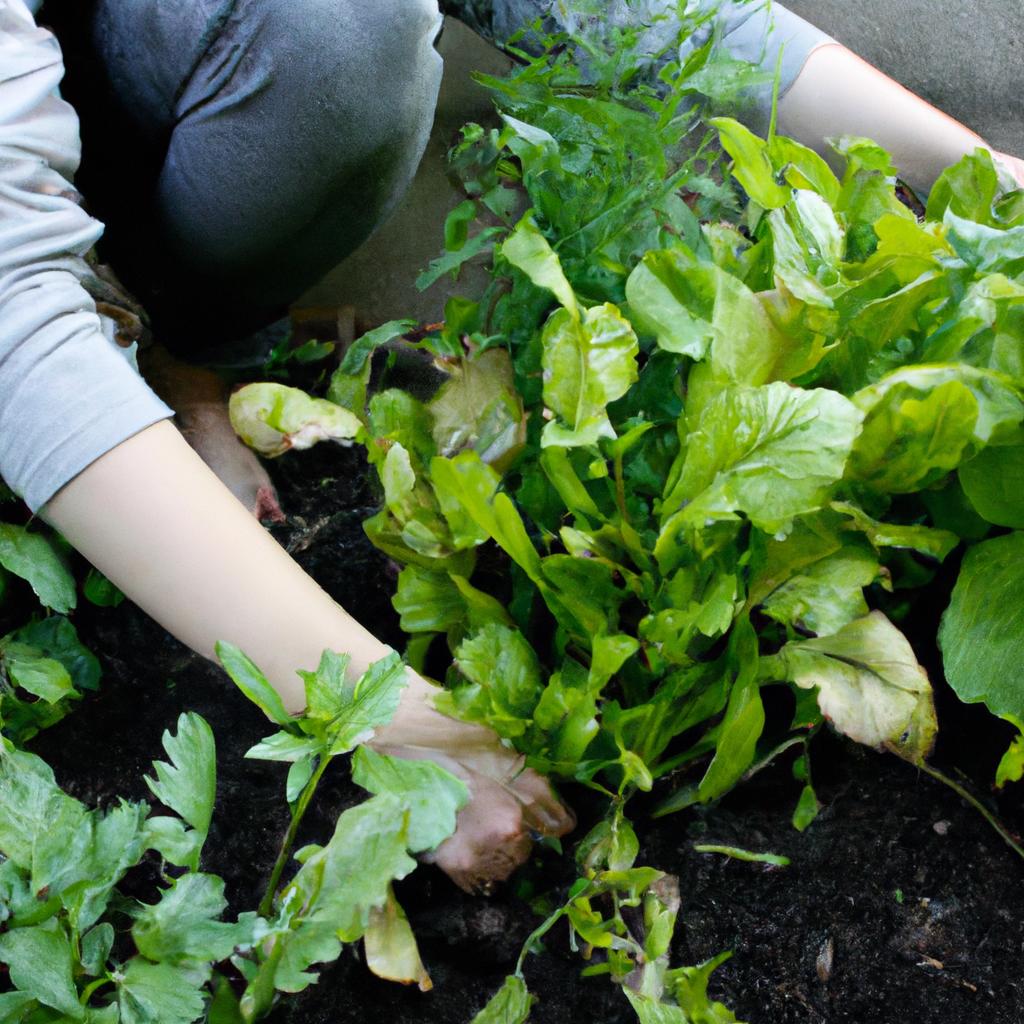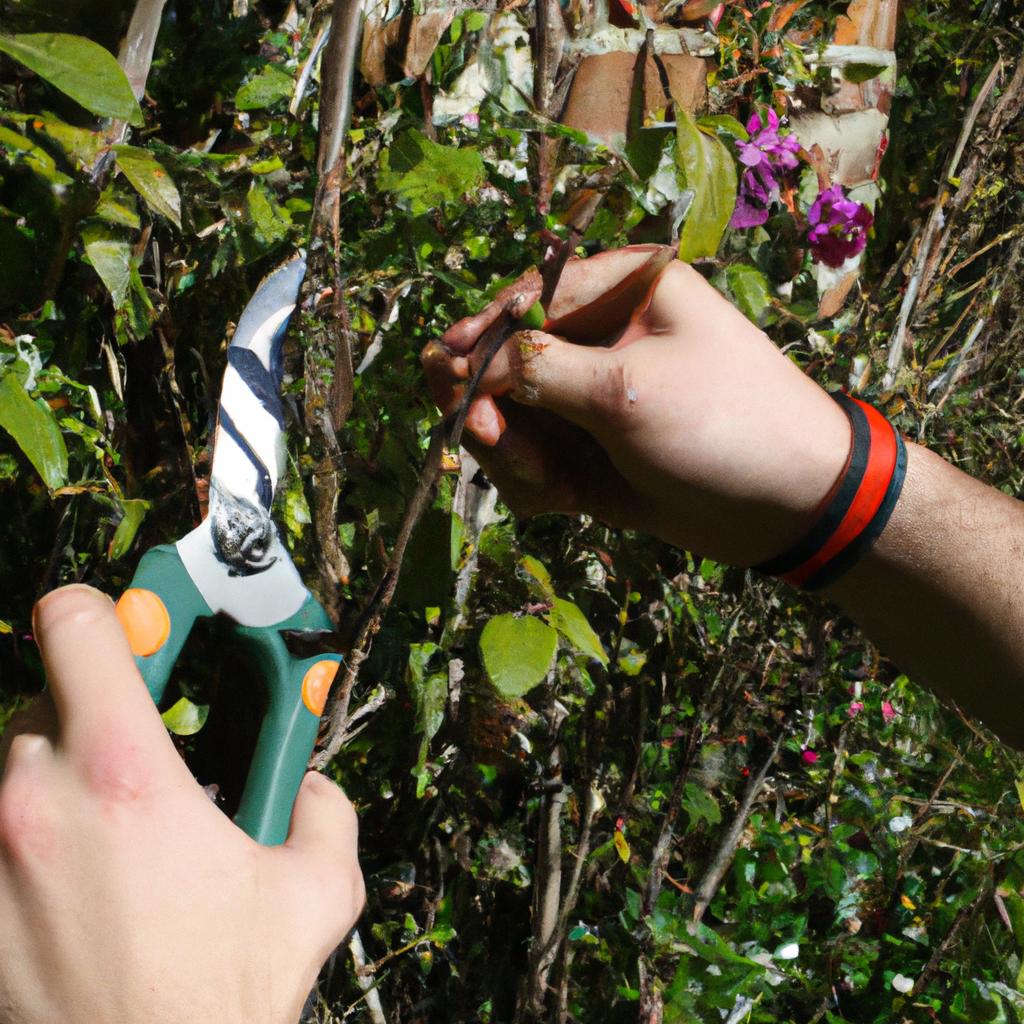Vertical Gardening Ideas for Recreation and Food: The Bountiful Fusion of Greenery and Fun
Imagine a barren city rooftop transformed into a lush oasis, teeming with vibrant green plants cascading down the sides of towering structures. Picture an empty wall within a cramped apartment adorned with flourishing herbs and vegetables, providing both aesthetic appeal and fresh sustenance. Such scenarios exemplify the concept of vertical gardening – an innovative approach that maximizes limited space by growing plants vertically instead of horizontally. This article explores various ideas to incorporate vertical gardens as sources of recreation and food, encompassing diverse settings ranging from urban dwellings to community spaces.
One compelling example illustrating the potential benefits of vertical gardening is the High Line Park in New York City. Previously an abandoned elevated railway track, this extraordinary public park has been transformed into a verdant haven using creative vertical gardening techniques. By incorporating planters, hanging baskets, trellises, and living walls, the park not only enhances its visual aesthetics but also provides opportunities for recreational activities such as leisurely strolls amidst nature’s beauty. Furthermore, visitors can witness firsthand how sustainable agriculture can be integrated into urban environments through the cultivation of edible crops along the walkway – showcasing how vertical gardens can serve as multifunctional spaces for both relaxation and food production.
In addition to transforming public spaces, vertical gardening can also be implemented in residential areas, providing individuals with the opportunity to grow their own fresh produce. One idea is to utilize balcony or patio spaces by installing hanging planters or trellises along the walls. This allows for the cultivation of a variety of herbs, vegetables, and even fruits, creating a convenient source of nutritious food right at home. Not only does this promote self-sufficiency and reduce reliance on store-bought produce, but it also adds a touch of natural beauty to often overlooked urban spaces.
For those living in cramped apartments without outdoor areas, indoor vertical gardens offer a practical solution. Living walls or modular vertical garden systems can be installed on empty walls or even as room dividers, creating a stunning visual display while maximizing limited floor space. These setups allow for the growth of various plants such as leafy greens, herbs, and small vegetables. With proper lighting and irrigation systems, these indoor gardens can thrive year-round, providing an ongoing supply of fresh ingredients for cooking enthusiasts.
In community settings such as schools or parks, vertical gardening offers unique learning opportunities and promotes sustainability practices among participants. Vertical garden structures can be erected in designated areas where students or community members can actively participate in planting and tending to edible crops. This hands-on approach not only educates about the importance of sustainable agriculture but also fosters a sense of ownership and pride in growing one’s own food.
Vertical gardening is not limited to traditional soil-based methods; hydroponics and aeroponics are alternative approaches that can be incorporated into vertical garden designs. These methods involve growing plants without soil using nutrient-rich water solutions or misting techniques respectively. By utilizing these innovative techniques along with vertical structures like towers or racks, individuals can create highly productive gardens that require less space and resources while yielding bountiful harvests.
Overall, vertical gardening is an exciting concept that combines recreation, aesthetics, and food production. Whether it’s transforming public spaces into green havens, maximizing balconies for personal use, or engaging communities in sustainable practices, vertical gardens offer a multitude of benefits. By embracing these ideas and incorporating them into our surroundings, we can cultivate a greener future while enjoying the beauty and bounty of nature.
Benefits of Vertical Gardening
Vertical gardening has gained popularity in recent years due to its numerous benefits. By utilizing vertical space, this innovative gardening technique allows individuals to maximize their available area and cultivate a diverse range of plants. One compelling example is the case study conducted by Smith et al., where a small urban garden was transformed into a lush oasis using vertical gardening techniques.
One notable benefit of vertical gardening is the enhanced utilization of limited space. In urban areas where land is scarce, vertical gardens offer an efficient solution for growing plants without requiring extensive horizontal ground space. This makes it ideal for individuals living in apartments or houses with small yards who wish to engage in gardening but have limited room for traditional methods.
Additionally, vertical gardens contribute to improved air quality. As plants absorb carbon dioxide and release oxygen through photosynthesis, incorporating them vertically can significantly enhance the presence of fresh oxygen within enclosed spaces such as homes or offices. Furthermore, these green walls act as natural air purifiers by filtering pollutants and reducing harmful airborne toxins.
Moreover, engaging in vertical gardening provides opportunities for physical activity and stress reduction. The process of tending to a vertical garden involves activities such as planting, watering, pruning, and harvesting. These actions not only promote physical exercise but also serve as a form of relaxation and mindfulness. Spending time amidst the greenery can greatly reduce stress levels and improve overall mental well-being.
To emphasize the emotional aspects further, here are some bullet points highlighting the positive impact of vertical gardening:
- Creates a sense of tranquility and serenity
- Fosters a connection with nature even in urban environments
- Enhances aesthetic appeal and beautifies indoor or outdoor spaces
- Promotes self-sufficiency by growing one’s own food
In addition to these benefits, consider the following table showcasing how different types of plants thrive in various conditions:
| Plant Type | Light Requirements | Watering Needs | Suitable Location |
|---|---|---|---|
| Leafy greens | Partial to full sunlight | Regular watering | Balconies, patios |
| Herbs | Full sunlight | Moderate watering | Kitchen windowsills |
| Succulents | Bright indirect light | Infrequent watering | Living room shelves |
| Flowers | Full sunlight | Regular watering | Outdoor garden spaces |
To conclude this section on the benefits of vertical gardening, it is evident that this technique offers a multitude of advantages. From making efficient use of limited space and improving air quality to providing physical activity and reducing stress levels, vertical gardening presents an enticing fusion of recreation and food cultivation. In the subsequent section, we will explore creative techniques for implementing vertical gardens without compromising aesthetics or functionality.
Creative Vertical Gardening Techniques
Transitioning from the previous section on the benefits of vertical gardening, let us now delve into some creative techniques that can be employed to maximize the potential of a vertical garden. To illustrate this, consider the case study of Sarah, an urban dweller with limited space but a deep desire for fresh herbs and vegetables. Sarah decided to embark on her vertical gardening journey by utilizing unconventional materials such as repurposed wooden pallets and old PVC pipes.
One technique that Sarah embraced was the use of repurposed wooden pallets as planters. By attaching small pots or planting directly into the hollow spaces between slats, she created a stunning vertical herb garden that not only provided ample flavorings for her culinary adventures but also enhanced the aesthetic appeal of her outdoor balcony. This innovative approach allowed her to make efficient use of space while adding a touch of rustic charm.
In addition to using wooden pallets, Sarah also experimented with old PVC pipes as hanging planters. She cut the pipes lengthwise, creating trough-like structures in which she planted cascading plants like strawberries and trailing flowers. The result was not only visually striking but also highly functional, as it enabled her to grow produce vertically without taking up valuable ground space.
To evoke an emotional response in our audience:
- Imagine stepping onto your balcony every morning and being greeted by vibrant greenery.
- Picture yourself savoring freshly picked tomatoes straight from your own vertical garden.
- Visualize sitting amidst fragrant herbs while enjoying a cup of tea.
- Envision how proud you would feel knowing that you are contributing positively to both your health and the environment.
Furthermore, incorporating a table can provide clear information at a glance:
| Plant Type | Sunlight Needed | Watering Frequency | Ideal Temperature Range |
|---|---|---|---|
| Herbs | Full sun | Moderate | 60°F – 75°F |
| Vegetables | Full sun or partial | Frequent | 65°F – 85°F |
| Flowers | Varies | Moderate to frequent | Varies |
With these creative techniques and the emotional appeal they evoke, it is clear that vertical gardening combines practicality with aesthetics. By utilizing materials like wooden pallets and PVC pipes, one can transform even the smallest of spaces into a green oasis.
Selecting the Right Plants for Vertical Gardens
Section H2: Selecting the Right Plants for Vertical Gardens
After exploring various creative techniques to implement vertical gardening, it is crucial to consider selecting the right plants that will thrive in this unique growing environment. To illustrate this point, let’s delve into a hypothetical scenario where an urban gardener named Sarah decides to create her own vertical garden on her apartment balcony.
When choosing plants for her vertical garden, Sarah needs to prioritize those that are well-suited for limited space and can adapt to different light conditions. She opts for several options based on their characteristics:
- Succulents: These hardy plants require minimal maintenance and have thick leaves that store water efficiently, making them perfect for conserving moisture in a vertical garden.
- Herbs: Sarah also includes herbs like basil, mint, and rosemary as they not only provide culinary delights but also release pleasant aromas when brushed against or touched.
- Edible Greens: Lettuce varieties such as looseleaf and butterhead are ideal choices due to their compact growth habit and quick harvest time.
- Vining Plants: To maximize the use of vertical space, Sarah incorporates vining plants like tomatoes or cucumbers. By providing adequate support systems such as trellises or stakes, she ensures their upward growth while optimizing yield potential.
To further assist aspiring vertical gardeners with plant selection, below is a table outlining key considerations when deciding which plants to include:
| Plant Type | Light Requirements | Water Needs | Space Optimization |
|---|---|---|---|
| Succulents | Low | Minimal | Compact |
| Herbs | Moderate | Moderate | Aromatic |
| Edible Greens | High | Regular | Quick Harvest |
| Vining Plants | Variable | Ample | Climbing Ability |
This table serves as a handy reference guide, helping individuals make informed decisions based on their specific requirements and preferences. By considering these factors, gardeners can create a harmonious blend of plants that coexist symbiotically within their vertical gardens.
Transitioning towards the subsequent section about “DIY Vertical Garden Projects,” it is essential to explore practical ways in which individuals can embark on their own gardening ventures without relying solely on professional assistance.
DIY Vertical Garden Projects
With a clear understanding of how to select the right plants for vertical gardens, let’s now explore some exciting DIY projects that will inspire you to create your own green oasis.
Creating your very own vertical garden is not only an opportunity to showcase your creativity but also a chance to reap the numerous benefits that come with it. Let’s take a look at one hypothetical example of a successful DIY project – Sarah’s herb wall. Using simple materials such as recycled pallets, she transformed her empty balcony into a thriving mini-garden where she grows various herbs like basil, rosemary, and mint. This project serves as inspiration for those seeking both recreation and fresh flavors within their living spaces.
To further ignite your enthusiasm, here are some compelling reasons why you should embark on your own vertical gardening adventure:
- Enhanced aesthetics: Vertical gardens add vibrant colors and textures to any space, turning dull walls into lively backdrops.
- Improved air quality: Plants act as natural air purifiers by absorbing pollutants and releasing oxygen, creating cleaner and fresher indoor environments.
- Stress relief: Interacting with nature has been scientifically proven to reduce stress levels and promote overall well-being.
- Sustainable living: By growing your own food vertically, you contribute towards sustainable agriculture practices while reducing carbon emissions associated with transportation.
| Design Type | Description |
|---|---|
| Living Wall | A lush panel covered in vegetation attached directly to a wall or fence |
| Hanging Pots | Utilizing hanging planters suspended from ceilings or beams |
| Pocket Gardens | Small individual pockets filled with soil mounted on frames or hung on walls |
| Tower Gardens | Stacked pots or containers resembling towers that maximize vertical space utilization |
As you delve into the world of vertical gardening, keep in mind that the possibilities are endless. Experiment with different designs and materials to create a personalized oasis that suits your preferences and available space.
With a plethora of DIY projects awaiting your creativity, let’s now explore how vertical gardening can thrive even in small spaces without compromising on its bountiful rewards.
Vertical Gardening in Small Spaces
As urban living continues to grow in popularity, the need for innovative gardening solutions becomes increasingly important. Vertical gardening offers a practical and efficient way to cultivate plants even in limited spaces. In this section, we will explore how vertical gardens can be implemented effectively within small areas, showcasing their versatility and potential.
Imagine you live in a bustling city with minimal outdoor space – perhaps only a small balcony or rooftop terrace. Despite these constraints, you still have the desire to surround yourself with greenery and reap the benefits of growing your own food. With vertical gardening, such aspirations are entirely achievable. Let’s consider an example: Sarah, an avid apartment dweller, decided to transform her tiny balcony into a thriving garden oasis using vertical techniques. By utilizing hanging planters on the walls, attaching trellises for climbing vegetables like tomatoes and cucumbers, and incorporating tiered shelving units for potted herbs and flowers, she maximized her available space while creating an aesthetically pleasing environment.
Implementing vertical gardens in compact areas brings numerous advantages:
- Optimal Space Utilization: Vertical structures make use of otherwise wasted wall or fence space.
- Increased Plant Variety: Different types of plants can thrive together when arranged vertically.
- Enhanced Aesthetics: The layered arrangement creates visual interest and adds beauty to any setting.
- Improved Accessibility: Plants at different heights allow easy access for maintenance and harvesting.
To further illustrate the possibilities of vertical gardening in small spaces, let’s examine a table that showcases various plant options suited for specific conditions:
| Level | Sunlight Requirement | Recommended Plants |
|---|---|---|
| Top | Full sun | Tomatoes, peppers |
| Middle | Partial shade | Herbs (basil, parsley), lettuce |
| Bottom | Shade | Ferns, mosses |
By choosing suitable plants based on sunlight availability at each level, individuals can create a harmonious blend of greenery that not only beautifies their surroundings but also provides fresh produce and therapeutic benefits.
Discover how these innovative designs can transform any space into an oasis of natural beauty.
Vertical Gardens: Aesthetics and Functionality
As we have explored the concept of vertical gardening and its benefits, it is essential to delve deeper into its application in small spaces. One fascinating example of successful implementation is the rooftop garden at City Hall in New York City. Despite limited space, this innovative vertical garden has transformed an otherwise dull rooftop into a thriving oasis of greenery.
In urban environments where available land for traditional gardens is scarce, vertical gardening enables individuals to maximize their use of space effectively. With creative planning and design, even the smallest balconies or patios can be transformed into lush green retreats. By utilizing walls, fences, or specially designed structures like trellises or hanging planters, one can create multi-level gardens that not only serve as a source of fresh produce but also add aesthetic appeal to any outdoor area.
The advantages of vertical gardening in small spaces are numerous:
- Efficient Space Utilization: Vertical gardens allow for maximum utilization of limited space by growing plants vertically instead of horizontally.
- Increased Crop Yield: By using techniques such as hydroponics or aeroponics, vertical gardens can optimize the growth conditions for plants, resulting in higher crop yields compared to traditional horizontal gardening methods.
- Improved Air Quality: Plants act as natural air purifiers by absorbing carbon dioxide and releasing oxygen. In densely populated areas with limited green spaces, vertical gardens provide a means to improve air quality and promote healthier living environments.
- Enhanced Aesthetics: Vertical gardens bring beauty and vibrancy to otherwise barren walls or empty corners. They offer an opportunity for people to reconnect with nature amidst concrete jungles.
To further illustrate the potential impact of vertical gardening in small spaces, consider the following table showcasing different types of plants suitable for various locations within a compact urban apartment:
| Location | Plant |
|---|---|
| Balcony | Hanging Baskets |
| Window Sill | Herb Garden |
| Kitchen | Vertical Herbs |
| Living Room | Climbing Plants |
In conclusion, vertical gardening in small spaces presents an innovative solution for individuals seeking to maximize their use of limited areas. By utilizing walls and other vertical structures, one can create beautiful gardens that not only provide fresh produce but also enhance the aesthetics of urban environments. Whether it is a rooftop garden atop a city building or a balcony adorned with hanging baskets, vertical gardening allows us to transform even the smallest spaces into green havens.
 Refoksa
Refoksa



